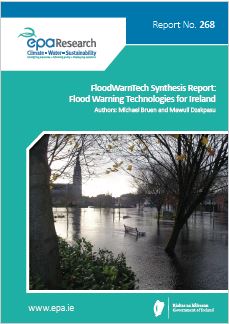Authors: Michael Bruen and Mawuli Dzakpasu
Summary: FloodWarnTech was an Environmental Protection Agency (EPA)-funded desk study of flood warning, with a specific focus on Ireland. Its objectives were to investigate (1) flood forecasting techniques and systems in use in Ireland and elsewhere; (2) methods and models best suited for use in Ireland; and (3) the optimal use of relevant data sources, observations and forecasts for flood forecasting.

This report is a response to the growing public and official pressure for Ireland to develop a world class flood forecasting capability to enhance the security of its citizens. It addresses some of the technical and modelling issues that must be resolved to respond to the pressure for an effective flood forecasting service. River flooding is a serious and contentious issue in Ireland, with most of its residential, industrial and transport infrastructure situated near watercourses with low gradients that frequently flood. Although some major structural flood protection schemes have been constructed by the Office of Public Works (OPW) and more are planned, cost–benefit requirements and public/stakeholder considerations are increasing the public pressure for bespoke non-structural solutions and these require operational flood forecasting and warning systems.
A strong case for a national flood forecasting centre has already been made and the Irish Government has set up a flood warning facility, operated by Met Éireann, in collaboration with the OPW. This project has reviewed international practice to inform appropriate technological decisions in the development of such a flood forecasting centre. In the context of the implementation of the EU Floods Directive, which has sparked the development of flood management schemes for the major flood risk areas of Ireland, information on the balance between physical protection and flood warning measures is necessary for cost effective solutions.
In response to the increasing public pressure for non-structural solutions to flood protection, demountable barriers and other temporary arrangements that are mobilised when a flood is forecast have been increasingly incorporated into flood protection schemes in Ireland. These allow normal access to rivers and flood-prone areas when no flood is forecast, but can be mobilised when a flood is expected. For these to be effective, an appropriate and timely warning of a flood event is required to enable flood managers to make decisions with regard to the activation of the demountable defences, blocking of roads and access to high-risk areas, etc. Such warnings must have a sufficient lead time to allow the defences to be erected and must also be reliable so that flood managers can have confidence in the decisions that ensue. This project has examined both the forecast lead time and the reliability of the best available technologies being used [hydrological, hydraulic models, telemetry from gauges, radar and numerical weather forecasting (for areas with rapid hydrological response times)]. This project was carried out in two stages. First, the issues were explored in a stakeholder workshop, which determined the immediate needs and future requirements of a wide range of stakeholders. This was followed by an examination of the capabilities of existing technologies used internationally in Irish conditions to enable them to be considered for implementation in operational warning systems. The project demonstrated selected examples of these technologies in a workshop, which showed the range of possibilities, from the simple to the sophisticated. Thus, the project provides practical, implementation-oriented information on existing and required technical capabilities, tailored, with examples, to the scales and situations typical of Irish rivers. The project implemented a hydrological forecast model for three test catchments of different sizes and with different degrees of data availability. In each, it compared the ability of the model to simulate flows with different sources of precipitation data. This project confirmed that effective flood warning solutions for large rivers are best based on good telemetry of real-time measurements of precipitation, together with the appropriate hydrological and hydraulic models. Although the use of upstream water levels was not assessed in this project, these are also expected to contribute to better forecasts in larger catchments. However, for many of the smaller Irish rivers with shorter lead times, the project shows that a good warning solution must not wait until the precipitation has occurred; it must predict the precipitation in advance and the performance of the warning system depends critically on the ability to make these predictions. Although the project has demonstrated the importance of the terrestrial rain-gauge network, it has also explored the performance and the added value of radar and numerical atmospheric model information for flood warning.
https://www.epa.ie/media/epa-2020/publications/research/Research_268_Thumbnail[1].jpg